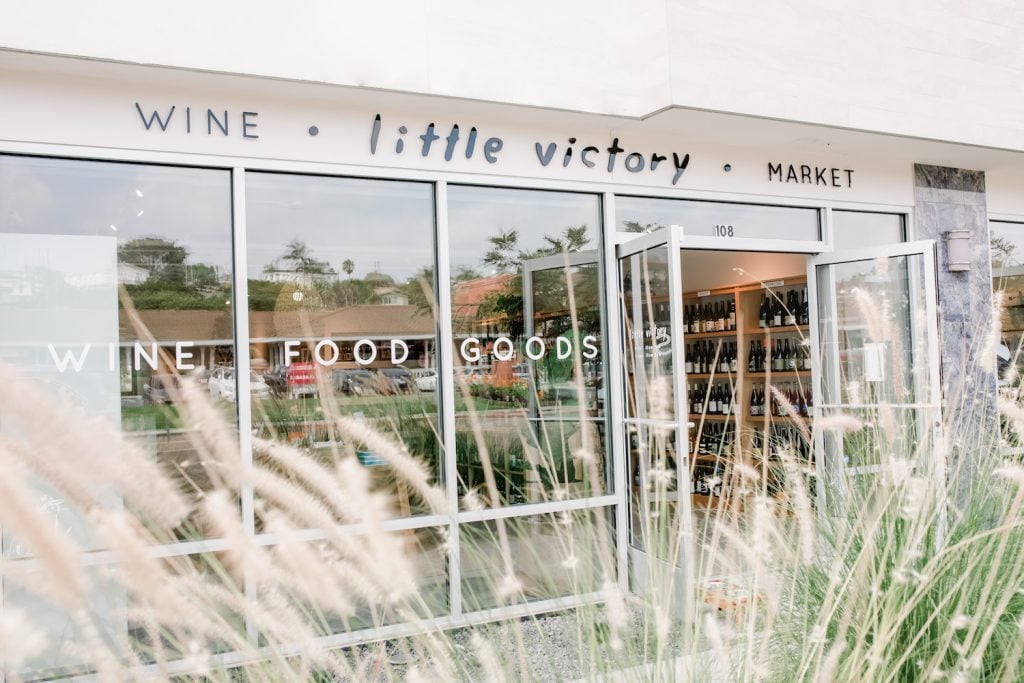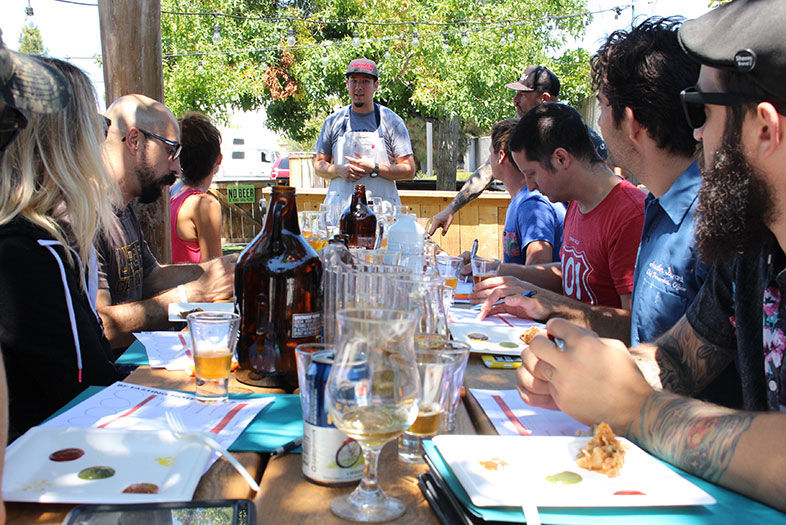It’s the most exciting thing happening in the world of beer and food today. Instead of simply pairing a certain finished beer with a finished dish, Colorado-based chef (but SoCal native!) Jensen Cummings actually prepares his dishes with many of the same techniques and ingredients that are used to make beer. Fermenting. Souring. Curing. Blending. Aging. These are the foundations of the Brewed Food technique. And they are redefining the boundaries of pairing beer with food.
Part of what’s so exciting about Jensen’s approach is that he’s questioning and rebelling against what have become tired and overused assumptions about pairing food with beer: Citrusy dishes pair with wheat beers, spicy foods pair with hoppy beers, chocolate desserts pair with stouts.
As Jesse Smith (Green Flash tasting room manager and certified cicerone) puts it, “Jensen is thought-forward as far as food and drink goes.” In his work, Jensen and his team are actually experimenting (in a lab!) and focus-testing flavor combinations of every conceivable kind, all in a quest to break down the barriers of what we commonly hold as food pairing truisms.
Jensen took an interest in exploring new cooking and preparation techniques beginning in 2014, while he was a chef and beer buyer for a restaurant in Denver, Colorado. [He was also the first chef in Denver to become a certified cicerone.] At that time, he had become, as he puts it, “bored with stale beer dinners” and felt strongly that chefs and brewers could collaborate on a deeper, more meaningful level by actually sharing the methods and procedures that form the foundations of brewing. “It was a very self-aware moment that I had,” Jensen recalls, “where I realized I was the problem. I knew I wanted to disrupt something, and I was the culprit for saying here’s a dish that will very safely make sense; it’s simple and it’s easy. But while I was cooking with the beer, I began to think, ‘Why would I marinate and cook with the beer that I’m pairing with? Of course they pair together! They taste the same!’ So it was an epiphany where I realized— shit—I was the problem.” That’s when the light bulb went on and it all became clear to Jensen. He realized that you have to look at brewing as a culinary art. And once you do that, a whole new world of possibilities opens up to you as a chef.
“Brewers are chefs,” Jensen says. “They’re cooking a liquid medium, but they’re cooking.” He points out that brewing requires attention to detail, care for ingredients, and a vision of the end product. All those things, he says, are nearly identical to what a chef does in a kitchen. Making this connection was a turning point in Jensen’s career. As he recalls, “Then it was no longer about beer, it was about brewing and cooking—and cooking as brewing.” That paradigm shift was the catalyst for the birth of the Brewed Food concept.
The next phase in the development of his ideas was figuring out, as he puts it, “How do I brew my food? How do I use those ingredients and those techniques and that inspiration and apply them as a core philosophy in cuisine?”
“It was no longer about beer, it was about brewing and cooking—and cooking as brewing.”
The most central process and technique in “brewing” food is fermentation. Jensen sees fermentation as a unique way to “coax out” a whole new level of flavor from ingredients. Plus, he adds, there’s the extra health bonus that comes built right into consuming probiotic-rich fermented foods.
When he first started out, Jensen was fermenting foods in a fridge in his garage. “I just had to experiment,” he recalls. “There were no resources for this. No cookbook. No YouTube videos. There was nothing to show me how to use lactobacillus and Belgian ale yeast strains to ferment kimchi. It just didn’t exist. So we had to test and test and test.” Jensen admits there were some early fermentation mishaps. Once, when a batch of kimchi exploded, he said his garage looked like “a scene from CSI with blood-spattered brain matter on the ceiling.”
The process of fermenting ingredients is at the very heart of the Brewed Food approach—but it’s only one of many. Jensen also incorporates brewing ingredients, such as wort, hops, and grain into his recipes. Even brewing by-products play a role; he has developed a number of recipes that use spent grain and hops. “Utilizing the by-products is a thoughtful means of usage in the kitchen,” Jensen says. “I remember the first time I walked outside at a brewery and saw thirty-two trash cans filled with spent grain, with flies all over them. I was mortified! At the same time, I’m smelling the grain and it has this amazing smell—like Grape-Nuts—and I just loved it!” Jensen was aware that some people had used spent grain in things like bread and pizza dough, but he was convinced that there were a whole lot more possibilities. So he started to brainstorm about all the ways to use spent grain in recipes. The benefits of this approach, as Jensen sees it, is twofold: he gets to innovate with ingredients that most chefs have not explored, but he also gets to develop a more sustainable relationship between brewing and cooking. The more that ingredients can be cross-utilized, the less waste there is on both sides.
Creating food with brewing techniques also—almost by default—creates pairings that are more complex and more potentially satisfying than those created along the old “traditional” pairing guidelines. Because brewed food itself is prepared in similar ways to the beer it accompanies, Jensen feels there’s a more natural affinity between the food and the beer. “You’re bringing out a whole new relationship that already exists,” Jensen says, “the interplay of inspiration, fermentation, and ingredients; it’s something that’s ever-present in the way that we interact with food and beverages. We’re just opening up a new ‘lane’ to be able to really connect the two.”
The more that ingredients can be cross-utilized, the less waste there is on both sides.
Jensen is quick to point out that the Brewed Food movement is not meant to negate or deny the beauty of many well-established, simple pairings. Yes, certain foods simply go well with certain beers. That’s a given. “I’m not trying to say that a nice crisp German Pilsner with a proper Bratwurst and a really fine brown mustard isn’t one of the most amazing things ever; it is. But we’ve been there. And I’m not trying to say that all those preconceived notions are wrong,” he says, “they’re just one-dimensional.” The challenge now, as Jensen sees it, is to understand the “building blocks” of what makes up those beautiful harmonies and to apply those building blocks and truisms to all styles of cuisine.
I was lucky enough to experience an evening of brewed food a few weeks ago, when Jensen collaborated with the folks at The Patio on Goldfinch to create a four-course dinner that featured a variety of innovative and exciting dishes with beer pairings from Green Flash/Cellar 3 and New Belgium. [Jensen, who is based in Denver, has been touring the country and presenting dinners in major cities like Austin, Portland, San Diego, and Brooklyn. He is supported by a number of great organizations, including New Belgium Brewing, Tender Belly Pork Company, and the Colorado Tourism Office.]
The dinner at The Patio was an mind-blowing mix of dozens of culinary brewing techniques that created dozens of flavors and an almost infinite variety of sensory combinations on the plates. For that reason, I won’t provide a full description of each dish and pairing—there’s just too much to say and you’d be reading this piece into next week. You can, however, get a good sense of the dishes and techniques used from a simple description of the courses:
The evening began with two small bites: First, a Tea-Smoked Scallop with Pickled Strawberry and Kaffir Lime that was paired with Green Flash’s Passion Fruit Kicker Wheat Ale. Second was a small piece of Pig Heart Yakitori sitting on a dollop of Malted Barley Miso and topped with a thinly sliced Grain-Zuke Radish. Paired with this was New Belgium’s Lips of Faith Tart Lychee, which somehow developed awesome notes of cinnamon when paired with the miso.
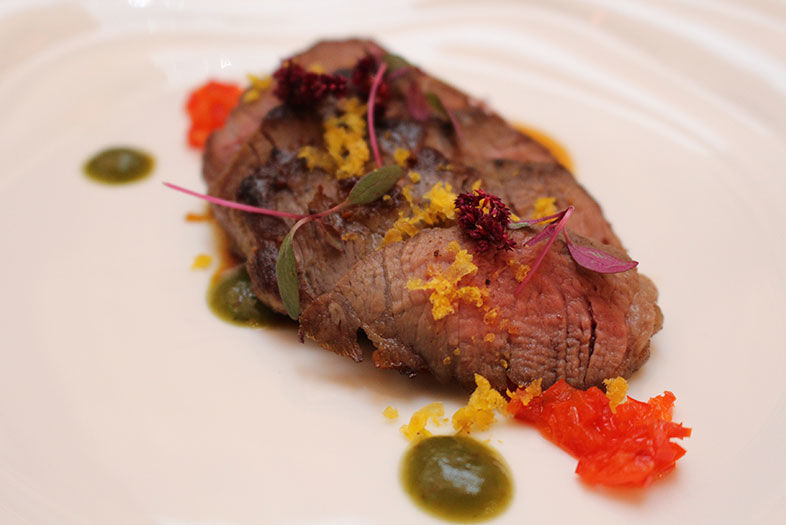
Inside the Brewed Food Movement
Beef Tataki with Wort Soy and Hop-Cured Egg Yolk. | Photo: Bruce Glassman
Beef Tataki with Wort Soy and Hop-Cured Egg Yolk. | Photo: Bruce Glassman
The first course featured Beef Tataki with Wort Soy, Fermented Yuzu Kosho (spicy green pepper sauce), and a sprinkling of Egg Yolk that had been cured in hops. Two contrasting beers were presented with this dish: New Belgium Fat Tire Amber Ale and New Belgium Citradelic Tangerine IPA. Each beer paired with the ingredients in a completely opposite way, but both worked surprisingly well.
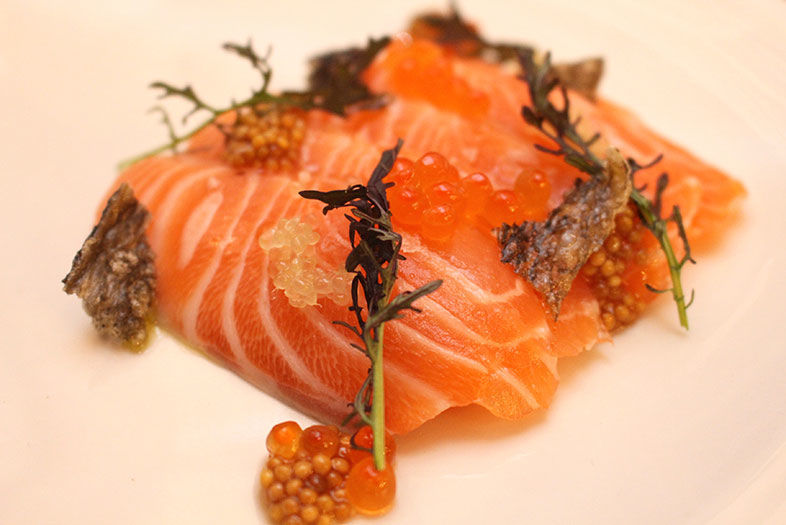
Inside the Brewed Food Movement
Salmon Crudo with Belgian-Beer-Cured Ikura and Pickled Mustard Seeds. | Photo: Bruce Glassman
Salmon Crudo with Belgian-Beer-Cured Ikura and Pickled Mustard Seeds. | Photo: Bruce Glassman
A Salmon Crudo with Crispy Salmon Skin, Cured Ikura (roe that’s been soaked in beer!), Pickled Mustard Seed, and Mustard Frill made up the second course, paired with Green Flash’s amazing Oculus Sauvage Belgian IPA. When I bit into the salmon roe, each little orange egg burst with a tiny bit of Belgian beer… amazing!
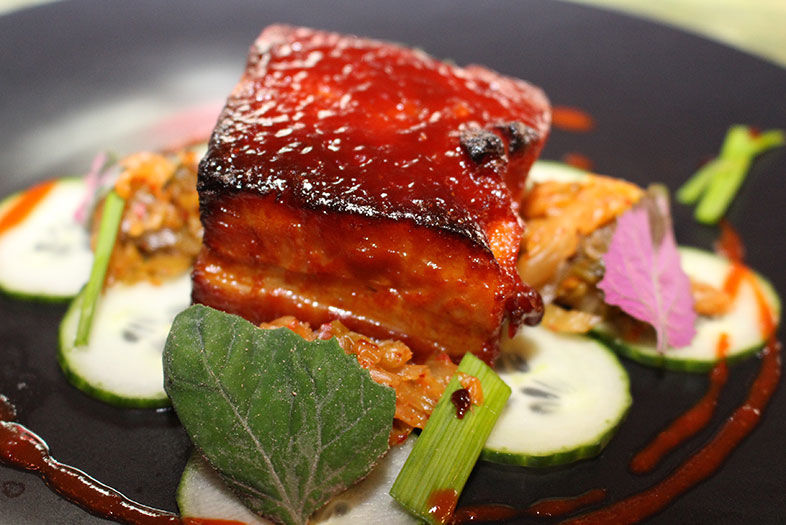
Inside the Brewed Food Movement
Pork Belly Bulgogi with Wild Yeast Kimchi and Funky Cherry Sriracha. | Photo: Bruce Glassman
Pork Belly Bulgogi with Wild Yeast Kimchi and Funky Cherry Sriracha. | Photo: Bruce Glassman
The third course featured a cube of tender Pork Bulgogi served atop a bed of Wild Yeast Baechu Kimchi (which was made with 4 different lactobacillus strains) and adorned with a ring of Funky Cherry Sriracha. New Belgium’s Trippel—with its deep malty character and banana notes—was the perfect foil for this spicy, rich, tart, and tangy dish.
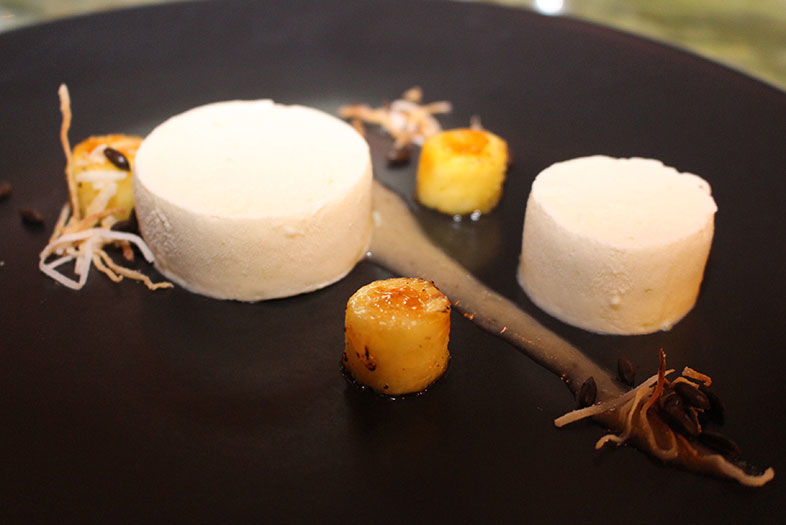
Inside the Brewed Food Movement
Coconut Semifreddo with Fermented Banana and Spent Grains. | Photo: Bruce Glassman
Coconut Semifreddo with Fermented Banana and Spent Grains. | Photo: Bruce Glassman
The evening ended with a dessert of Coconut Semifreddo and Caramelized Pineapple, accompanied by a sauce made from Fermented Banana and sprinkled with spent grain. Bourbon Barrel Divine Frumento (the Belgian Trippel from Green Flash) was the dark and delicious partner for this dish. The rich, heavy body of the beer, which had hints of coconut, was a delightful counterpoint to the lightness and coolness of the semifreddo and pineapple.
Jensen hopes that his Brewed Food ideas can inspire people to explore a whole host of new flavors and textures while dining, but he also hopes that his techniques will get folks to start experimenting with fermentation on their own. “Brewed Food has two lanes,” he explains. “First, we have our food lab and our test kitchen where we’re really pushing innovation hard. And then we have our movement side. That’s about getting out there and finding people who are more talented and way smarter than I am. People who can take this to a place that I can’t even imagine, doing things that are relevant to them.”
More than anything else, Jensen wants the Brewed Food movement to shake up the old embedded notions about what beer and food can achieve together. “It’s about exploration. And it’s very thought-provoking,” he says. “The dinner we did at The Patio was not just about coming, sitting down, relaxing, and enjoying the show; the diners were active participants in what was going on. They were the ‘fifth element’… the ‘sixth taste’ we’re trying to learn about. We need them because the human variable is always the hardest variable to understand.”
You can learn more about the Brewed Food movement at:
Facebook: Brewed Food
Twitter: @brewedfood
Instagram: @brewedfood
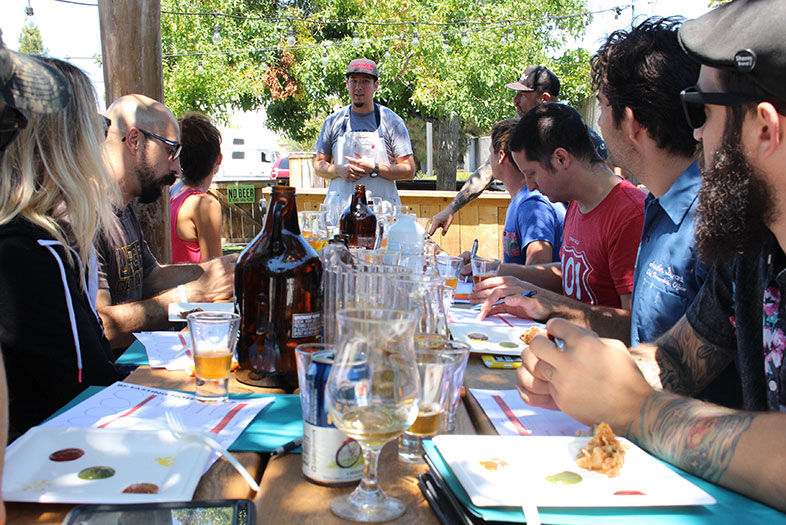
Inside the Brewed Food Movement
Jensen Cummings led a sensory tasting panel for local chefs at Green Flash. | Photo: Bruce Glassman


